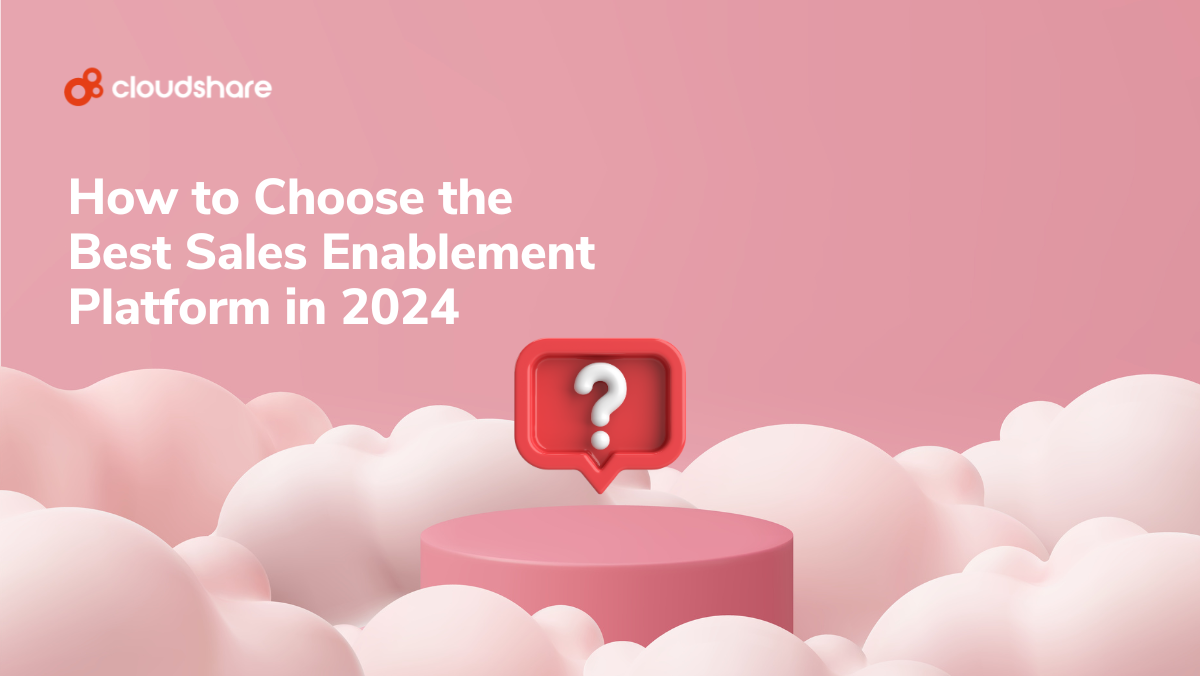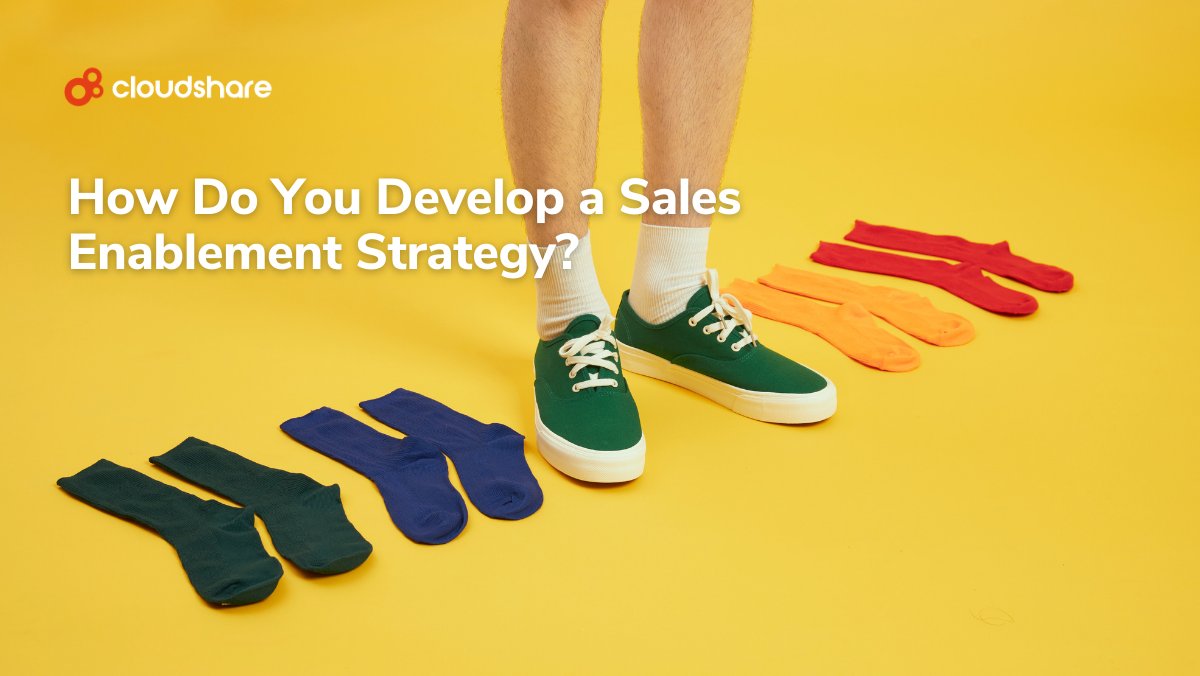
Sales enablement has one overarching goal: empowering your sales team to find the best ways to engage with the customer. It’s arguably one of the most important initiatives for your organization. After all, if your salespeople can’t connect with their audience, they cannot properly do their job.
Effective sales enablement demands that you provide your team not only with the necessary training, but also with the content, data, and tools they require to succeed — typically via a sales enablement platform.
What Is a Sales Enablement Platform?
A sales enablement platform is a software-based collection of sales tools and technology geared towards optimizing the sales cycle. This consolidated toolkit allows salespeople to work smarter when promoting a business’s products instead of requiring them to work harder. It’s arguably the cornerstone of every sales strategy, as well.
One might even go so far as to argue that without a sales enablement solution, a company cannot feasibly remain competitive.
Types of Sales Enablement Tools
Because sales enablement encompasses the entire sales process, it shouldn’t be surprising that there are many different types of sales enablement tools. The majority of tools fall into one or more of the categories listed below. Many vendors offer a sales enablement solution that encompasses all the characteristics below with several additional features — we’ll discuss that more later in the piece.
Engagement
This is exactly what’s written on the tin — engagement tools connect your sales team with customers and prospects. This category encompasses both the tools your team uses to communicate and the tools that help them communicate more effectively. Examples include CRM software, social messaging tools, and email outreach platforms.
Content Management
Content management tools allow your sales team to organize and consolidate sales collateral such as blog posts, case studies, and white papers. Content management tools may also cover internal content such as a sales playbook or messaging document.
Recently, a new subset of content management platforms has emerged that focuses on creating and distributing short-form videos similar to what one would find on platforms like TikTok.
Training
Re-skilling and upskilling are a critical part of sales enablement. Your sales team needs to possess a thorough understanding of both the software they’re selling and the tools they’ll use to do so. Training tools such as virtual labs help to develop this understanding.
Sales Intelligence
Sales intelligence tools provide your team with valuable insights into the behavior, intent, and needs of prospects. In addition to monitoring engagement, this category of analytics software helps optimize your sales process, improve collaboration between sales and marketing and embrace continuous improvement.
What are the Benefits of an Enterprise Sales Enablement Platform?
The benefits of choosing the right sales enablement toolkit include:
- Efficiency: Sales enablement streamlines the sales cycle, allowing your team to more effectively and efficiently identify and engage with qualified leads. This typically results in both a higher rate of success and a larger volume of closed deals.
- Empowerment: From better training to improved product demos, a sales enablement platform doesn’t just optimize the sales process. It also allows your people to improve, enhancing their performance through skills development and allowing for new sales strategies and helping them more effectively keep pace with new and emerging trends.
- Collaboration: A good sales enablement solution acts as a bridge between sales, marketing, and customer success. It empowers all three departments, allowing them to work more effectively with one another through shared tools and knowledge.
- A Better Buyer’s Journey: Success in sales is all about providing the best experience possible to your prospects. Integrating sales enablement into your existing ecosystem ensures a better experience at every stage of the sales funnel, allowing for improved personalization, more compelling and interactive product pitches, and faster response times.
- Increased Deal Sizes: Sales enablement software makes it far easier for salespeople to identify cross-selling and upselling opportunities. This potentially results in better deals while also generating more revenue from existing customers.
Critical Sales Enablement Platform Features
There is no such thing as a one-size-fits-all solution in sales enablement. Every business, even within the same niche, has different sales enablement needs. Any vendor worth consideration will understand this and be willing to customize their offering in order to fit your unique use case.
There are certain key features that are universal, however:
- Consolidation: Your sales team should be able to create, customize, and organize sales collateral within a single repository accessible to anyone that requires it. Said repository should also serve as a single source of truth for customer data.
- Content Delivery: Your sales team should be able to deliver targeted content to both current and prospective buyers based on various criteria and across multiple channels, including email, social media, search ads, display ads, and text messages.
- Analytics: Sales is ultimately a data-driven profession. It follows, then, that sales enablement must provide salespeople with a way to not only gain insights into the needs and requirements of their customers, but also their own performance.
- Process Optimization: Sales enablement at its core is all about efficiency. An effective platform must therefore provide a range of tools for automating processes such as lead generation, content delivery, and lead nurturing.
- Training: The best sales enablement platforms typically feature a robust suite of training tools. In addition to improving internal onboarding and providing salespeople with the opportunity to develop new skills and competencies, these tools also allow your company to improve both its product demonstrations and its customer onboarding.
- Integration: Your sales enablement solution should integrate seamlessly with existing software and systems where it doesn’t provide that functionality out-of-the-box. This may include, but is not limited to, customer relationship management, marketing automation, and content management.
Factors to Consider When Evaluating Sales Enablement Solutions
As we already established, there’s no such thing as one-size-fits-all in the world of sales enablement. What works for your organization likely won’t work for another company, and vice-versa. With that in mind, there are a few things you’ll need to consider in your search for a sales enablement tool:
- Industry Specific Needs: Does your company have to follow any regulatory guidelines or standards? What challenges and pain points are unique to customers in your target markets?
- Organizational Structure: How is your company structured, and how does your sales team typically manage their projects? What does the business’s overall hierarchy look like? What about roles and responsibilities?
- Internal Expertise: Do you already employ an existing sales enablement team? If not, you may want to consider doing so. At the very least, it may be worthwhile to hire a sales enablement professional to oversee strategy, training, and coordination.
- Business Objectives: What are the overarching goals that your business is trying to achieve, and what measures are you taking to ensure they’re aligned with your sales department’s objectives?
- Sales Enablement Goals: What are you trying to achieve in deploying a sales enablement solution? Do you want to decrease time to revenue? Increase sales productivity? Improve customer retention?
- Products and Services: What problems does your software solve for your customers? Do you have any other products or services in your portfolio in addition to your core offering? If so, what do they do?
- Existing Tech Stack: What tools does your sales team currently leverage? Does the sales enablement platform you’re considering offer functionality that can replace these tools? If not, how well will the platform integrate with your existing software ecosystem?
- Ease of Use: Does the software run relatively well on its own, or will your business be required to spend a significant amount of time on maintenance and upkeep?
- Sales Cycle: How complex is your sales cycle? Do your salespeople require any specialized technical knowledge or skills? How much time typically passes from identifying an initial prospect and closing a deal?
- Critical Features: Prior to beginning your search for a sales enablement vendor, it’s a good idea to create a list of must-have features along with a list of nice-to-have features. This will allow you to identify which vendors are worth following up with.
- Resources: How much is your business willing to spend on a sales enablement solution? How much time and effort can you put into installation, deployment, and training?
- Other Requirements: It goes without saying that your sales team should be involved in selecting and assessing a sales enablement platform. However, they’re not the only people you should consult. It’s important to involve stakeholders at every level of your organization, and from all departments that interact either directly or indirectly with sales.
How to Compare Sales Enablement Platforms
There exists an absolutely staggering amount of sales enablement vendors online, and not all of these vendors are created equal. As a result, determining which one is the right fit for your business may not be as simple as identifying your needs. When comparing platforms and vendors, you’ll need to keep the following in mind:
- Rollout: If everything goes as planned, how long will each sales enablement platform you’re considering take to configure and deploy? Is there a significant learning curve to using the software, or is training relatively straightforward? What sort of support does the vendor provide during the deployment?
On your side, are you working against a strict timeline, or do you have a bit more flexibility in rolling out a solution? - Vendor Attitude: What does the vendor’s customer support look like? Do they position themself as a trusted partner, or are they almost entirely hands-off after a sale is made? Most importantly, do they offer 24/7 product and technical support?
- Pricing: How much flexibility does the vendor provide in terms of how and when your business pays? Do they charge on a monthly basis, require an annual subscription, or offer usage-based pricing?
- Contracts: What sort of contract does the vendor require your organization to sign as part of their onboarding process? Does that contract feature a generous service-level agreement? What about hidden charges?
- Security: What approach does the vendor take where cybersecurity is concerned? How effectively do they prioritize data integrity and data protection? Does their platform adhere to the compliance requirements of your industry?
- Reviews: What are people saying about the vendor and their solutions online? Are their reviews mostly positive, or overwhelmingly negative? Consider how well-known the vendor is, as well — are there reviews of them on multiple websites, or does information about them seem relatively sparse?
Let’s say you’ve gotten through all of the criteria above and still can’t decide which vendor you should choose. There’s one final step involved in the selection process, and it’s arguably the most important of all. Run a short pilot project with each vendor, then assess:
- How well they met your needs.
- Their impact on your sales cycle.
- Employee feedback.
- Their potential return on investment.
- Whether there were any problems during the pilot, and if so, how effectively the vendor addressed those issues.
- The strengths and weaknesses of the vendor and their offering.
- Features you or your team particularly liked or disliked.
Looking for a Sales Enablement Platform? Try CloudShare Today
Choosing a sales enablement solution can be a daunting prospect, but it doesn’t have to be. At the end of the day, it’s really just a matter of doing your research. We encourage you to read our influencers’ guide to mastering Sales Enablement, taking a deep dive into top challenges, skills, and tech. Interested in learning how CloudShare stacks up to the competition? Schedule a demo with one of our experts.
This blog was originally posted in June 2023, and updated in February 2024.



